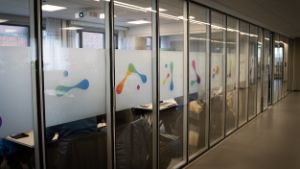Tidligere arrangementer - Side 6
Multiclass Classification Of Leptons In Proton-Proton Collisions At sqrt{s}=13 TeV Using Machine Learning
Benchmarking and Optimization of Cardiac Electrophysiology Solvers
Machine Learning for Exploration of Silica Structures Using Molecular Dynamics
Machine Learning for Exploration of Mechanical Structures Using Molecular Dynamics
Evaluating Approximate Methods for Computing Extracellular Potentials from Neuronal Networks
Deep learning to estimate power output from breathing
Intergrating computing in the diciplines change both the subject and the way we teach. How do we meet these changes?
Beregninger i fagene endrer både faget og måten vi underviser på. Hvordan møter vi disse endringene?
Electronic and Optical Properties of Two-Dimensional BaSi2
Constructive alignment of learning aims, examination and learning activities is a convincing principle for course design. However, to make a meaningful alignment, we first need to precisely define and understand these aspects in the context of a given course. For instance, if learning aims are to truly guide/define examination and learning activities, we need a rich conception of learning aims that goes well beyond the short, general and typically vague formulations provided on course web pages. As always, devil is in the details. To initiate a discussion, I will show examples of how we have tried to face the challenge of being sufficiently concrete in our approach to constructive alignment in the course IN1000 (a large introductory programming course at UiO).
After having taught computing in a mathematical setting for many years, I have collected a number of observations and hypotheses about how students develop their understanding. In particular I have seen many examples of how computing triggers understanding of mathematical concepts. Some of these are quite standard, eg. numerical integration as a tool to extend the understanding of the definition of the integral. In this talk I will discuss some fairly obvious examples of this kind, but I will focus on some less obvious examples. Hopefully, this will illustrate that computing can be integrated fruitfully with mathematics in areas far beyond what we do today.
In the new CompSci MSCA PhD program we will educate 32 PHD-students across the faculty. They will all have a 20 ECTS intensive introduction course in computing and data science. This will open new opportunities to develop PhD-level courses in the spirit of the CS program. I will introduce a discussion of what the contents and level of such courses should be with a particular focus on how Fys4150 and Fys-stk4155 can be adapted to students with diverse computational skills.
It would be a mistake to assume that students have learned the thing you just presented to them. Formative assessment is thus concerned with informing both the teacher and the student about how much students understand about a topic, and discover any misunderstandings.
The seminar will be in Norwegian: "Vi presenterer en modell for kompetanseheving i realfaglig programmering for lærere. Modellen tar for seg opplæring i programmering på fagenes premisser, og vi ser på hvordan en slik modell kan brukes for lærere i høyere utdanning."
Computational thinking are by some defined as the capability to resolve problems algorithmically and logically, including skills related to representing, organizing and identifying patterns in data. This may be seen as leaning in a direction of discrete and observable processes. The Norwegian translation to "algoritmisk tenkning" can be read even clearer in the direction of defining explicit, deterministic instructions to achieve a well understood outcome. At the same time, computational thinking is not only promoted as a means to allow the development of concrete code/algorithms, but also as a way of thinking constructively about phenomena in a variety of fields. And it is clearly not the case that all phenomena in nature and society only involve discrete, directly observed entities - to the contrary, many relations and processes we may be interested in are continuous and probabilistic in their nature, where we have to constructively relate to risks, uncertainties and underlying patterns. An interesting question is whether the ability to devise algorithms to solve well defined problems and the ability to relate constructively to questions in an uncertain world should be seen as two aspects of the same skillset, or as separate skills that are cultivated through separate learning experiences.
What do we mean by "learning programming", why do many find it challenging to learn, what are really the main challenges, which aspects do people in different settings need to learn and how do they best learn it? Geir Kjetil Sandve will give a brief introduction to a discussion where we look forward to hearing experiences and viewpoints inspired by the myriad settings where people in our environment have been involved in programming.
Tor Ole Odden:
"The field of educational research has a massive literature base, with many journals that have been publishing articles for almost a century (or longer). How do we sort through and make sense of literature at this scale? We have begun using an unsupervised machine learning technique from the field of natural language processing, known as latent Dirichlet allocation, to analyze articles from the fields of physics education research and science education research. This technique allows us to extract latent themes, or topics, from the literature and quantify the rise and fall of those topics over time.
In this talk, I will present the basics of the technique, describe some of its underlying theory and applications, and showcase some of the trends that it reveals in how science education theory and practice has evolved over the last 20-100 years."



